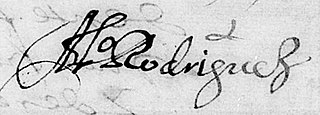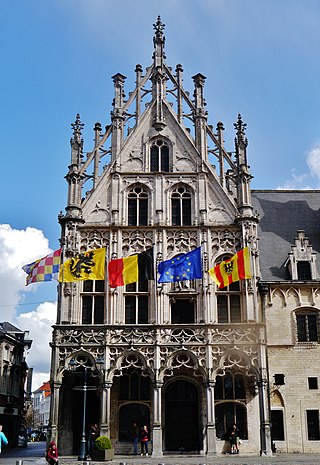
The Río de la Plata, also called the River Plate or La Plata River in English, is the estuary formed by the confluence of the Uruguay River and the Paraná River at Punta Gorda. It empties into the Atlantic Ocean and forms a funnel-shaped indentation on the southeastern coastline of South America. Depending on the geographer, the Río de la Plata may be considered a river, an estuary, a gulf, or a marginal sea. If considered a river, it is the widest in the world, with a maximum width of 220 kilometres (140 mi).

Ministro Pistarini International Airport, also known as Ezeiza International Airport owing to its location in Ezeiza in Greater Buenos Aires, is an international airport 22 kilometres (14 mi) south-southwest of the autonomous city of Buenos Aires, the capital city of Argentina. Covering 3,475 hectares, it is one of two commercial airports serving Buenos Aires and its metropolitan area, along with Aeroparque Jorge Newbery. Pistarini Airport is the country's largest international airport by number of passengers handled—85% of international traffic—and is a hub for international flights of Aerolíneas Argentinas, which operates domestic services from the airport as well. It has been operated by Aeropuertos Argentina 2000 S.A. since 1998.

Carlos María de Alvear, was an Argentine soldier and statesman, Supreme Director of the United Provinces of the Río de la Plata in 1815.

The Viceroyalty of the Río de la Plata meaning "River of the Silver", also called "Viceroyalty of the River Plate" in some scholarly writings, in southern South America, was the last to be organized and also the shortest-lived of the Viceroyalties of the Spanish Empire in the Americas. The name "Provincias del Río de la Plata" was formally adopted in 1810 during the Cortes of Cádiz to designate the Viceroyalty of the Río de la Plata.
Carlos Thays was a French-Argentine landscape architect, and a student of French landscape architect Édouard André.

The United Provinces of the Río de la Plata, earlier known as the United Provinces of South America, was a name adopted in 1816 by the Congress of Tucumán for the region of South America that declared independence in 1816, with the Sovereign Congress taking place in 1813, during the Argentine War of Independence (1810–1818) that began with the May Revolution in 1810. It originally comprised rebellious territories of the former Spanish Viceroyalty of the Río de la Plata dependencies and had Buenos Aires as its capital.

The Cisplatine War, also known as the Argentine-Brazilian War or, in Argentine and Uruguayan historiography, as the Brazil War, the War against the Empire of Brazil or the Liberating Crusade in Uruguay, was an armed conflict in the 1820s between the United Provinces of the Río de la Plata and the Empire of Brazil over Brazil's Cisplatina province, in the aftermath of the United Provinces' and Brazil's independence from Spain and Portugal respectively. It resulted in the independence of Cisplatina as the Oriental Republic of Uruguay.

Banco de la Nación Argentina is a national bank in Argentina, and the largest in the country's banking sector.

Zwi Migdal was a criminal organisation founded by Jews in Poland in the 19th century, based mainly in Argentina.

Hernando Arias de Saavedra, commonly known as Hernandarias, was a soldier and politician of criollo ancestry. He was the first person born in the Americas to become a governor of a European colony in the New World, serving two terms as governor of Governorate of the Río de la Plata, 1597–1599 and 1602–1609, and one of the Governorate of Paraguay 1615–1617.

The term travesti is used in Latin America to designate people who were assigned male at birth and develop a feminine gender identity. Other terms have been invented and are used in South America in an attempt to further distinguish it from cross-dressing, drag, and pathologizing connotations. In Spain, the term was used in a similar way during the Franco era, but it was replaced with the advent of the medical model of transsexuality in the late 1980s and early 1990s, in order to rule out negative stereotypes. The arrival of these concepts occurred later in Latin America than in Europe, so the concept of travesti lasted, with various connotations.

Manuel Zorrilla de la Torre was an Argentinian painter, illustrator, engraver, drawer, and sculptor. His parents were Spanish immigrants.

The Inca plan was a proposal formulated in 1816 by Manuel Belgrano to the Congress of Tucumán, aiming to crown an Inca. After the Declaration of Independence of the United Provinces of South America, the Congress discussed the form of government that should be used. Belgrano proposed that the country be ruled by a Constitutional monarchy headed by an ethnic Inca. The proposal was supported by José de San Martín, Martín Miguel de Güemes and the northern provinces, but found strong resistance from Buenos Aires. The Congress would ultimately reject it, creating instead a Republican government.
Atlético, Spanish for athletics, or Athletico in English, may refer to:

Alfonso Rodríguez was a Spanish mariner and merchant, who was colonizer in the cities of Río de Janeiro and Buenos Aires in the 1620s. He served as a captain of commercial ships, having an active participation in the commerce of Río de la Plata towards the middle of the 17th century.

This is a chronological list of live performances by Alfredo Rossi from 1919 to 1983. The list is incomplete because no concerts without references are listed.

The list of city flags lists the flags of cities. Most of the city flags are based on the coat of arms or emblems of its city itself, and city flags can be also used by the coat of arms and emblems on its flag. Most of the city flags are flown outside town halls and councils.
The 2021 Copa Libertadores final stages were played from 13 July to 27 November 2021. A total of 16 teams competed in the final stages to decide the champions of the 2021 Copa Libertadores, with the final played in Montevideo, Uruguay at Estadio Centenario.


















